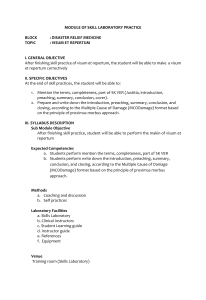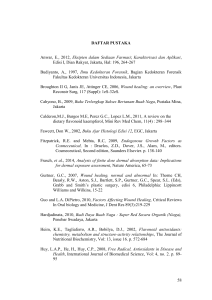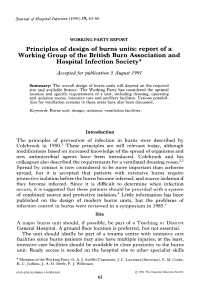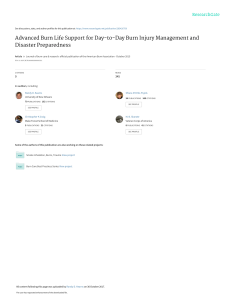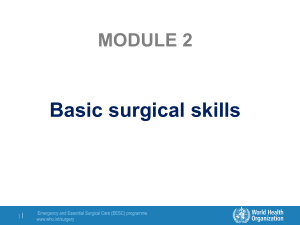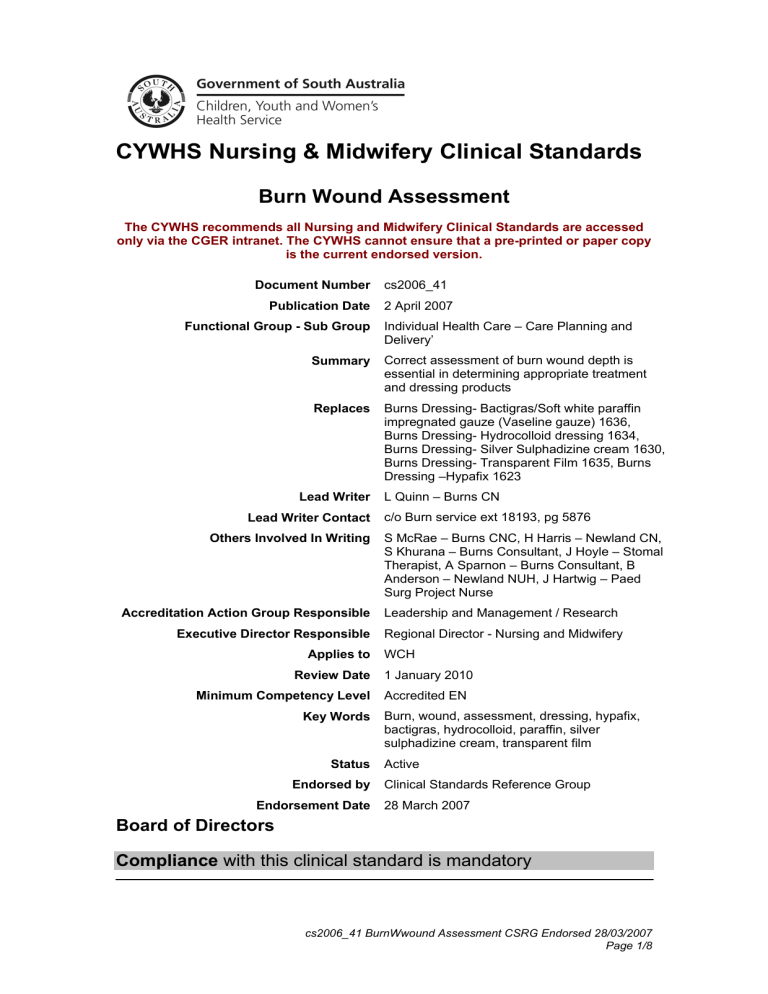
CYWHS Nursing & Midwifery Clinical Standards Burn Wound Assessment The CYWHS recommends all Nursing and Midwifery Clinical Standards are accessed only via the CGER intranet. The CYWHS cannot ensure that a pre-printed or paper copy is the current endorsed version. Document Number Publication Date Functional Group - Sub Group cs2006_41 2 April 2007 Individual Health Care – Care Planning and Delivery’ Summary Correct assessment of burn wound depth is essential in determining appropriate treatment and dressing products Replaces Burns Dressing- Bactigras/Soft white paraffin impregnated gauze (Vaseline gauze) 1636, Burns Dressing- Hydrocolloid dressing 1634, Burns Dressing- Silver Sulphadizine cream 1630, Burns Dressing- Transparent Film 1635, Burns Dressing –Hypafix 1623 Lead Writer Lead Writer Contact Others Involved In Writing Accreditation Action Group Responsible Executive Director Responsible Applies to Review Date Minimum Competency Level Key Words Status Endorsed by Endorsement Date L Quinn – Burns CN c/o Burn service ext 18193, pg 5876 S McRae – Burns CNC, H Harris – Newland CN, S Khurana – Burns Consultant, J Hoyle – Stomal Therapist, A Sparnon – Burns Consultant, B Anderson – Newland NUH, J Hartwig – Paed Surg Project Nurse Leadership and Management / Research Regional Director - Nursing and Midwifery WCH 1 January 2010 Accredited EN Burn, wound, assessment, dressing, hypafix, bactigras, hydrocolloid, paraffin, silver sulphadizine cream, transparent film Active Clinical Standards Reference Group 28 March 2007 Board of Directors Compliance with this clinical standard is mandatory cs2006_41 BurnWwound Assessment CSRG Endorsed 28/03/2007 Page 1/8 CYWHS Nursing & Midwifery Clinical Standard Burn Wound Assessment The CYWHS recommends all Nursing and Midwifery Clinical Standards are accessed only via the CGER intranet. The CYWHS cannot ensure that a pre-printed or paper copy is the current endorsed version. This Clinical Standard was printed on Introduction Burns are a common form of trauma.1% of the population of Australia and Zealand (200,000) suffer burns each year.1 There are five classifications of burn depth: • • • • • Epidermal Superficial Dermal Mid Dermal Deep Dermal Full Thickness Accurate assessment of burn depth on admission is important in making decisions about dressings and surgery.9 Definition(s) Epidermal: 4 • • Appearance - pink or red erythema with no blisters. Capillary return – Rapid <2 seconds. cs2006_41 Burn Wound Assessment CSRG Endorsed 28/03/2007 Page 2/8 • • • • • Sensation - painful. Outcome – will heal in 3-5 days with no resulting cosmetic blemish. Most common cause is sunburn. May require hospitalisation for pain management. Pure erythema is not included in estimation of TBSA. Differentiation between erythema and superficial dermal burn may be difficult in the first few hours following the burn injury. 8 Superficial Dermal 4 • • • • Appearance – Wet, pale pink or blotchy with blisters, when blister is debrided the dermis will be exposed, potentially increasing depth of tissue loss. Epidermis may not lift off for 12 to 24 hours increasing risk of inaccurate assessment of burn as superficial epidermal. Capillary return – Brisk <2 seconds. Sensation – Very painful as sensory nerves are exposed. Outcome – Will heal in 7-10 days as epidermal appendages remain intact. Minimal or no scarring but a colour defect may remain. cs2006_41 Burn Wound Assessment CSRG Endorsed 28/03/2007 Page 3/8 8 Mid Dermal: 4 • • • • • Appearance – Red, dark pink, white with blisters. Capillary return – Sluggish, varies with depth. Sensation – Adequate. Outcome – Will heal in 10 to 14 days, except in the very young and elderly where the dermis is thin and depth of burn is invariably deeper. This type of burn injury is highly susceptible to conversion to a deeper thickness wound. Factors that may deepen wound include inadequate first aid, co-morbidities, poor resuscitation, inappropriate wound management or dressing choice, patient age, vasoconstriction from over cooling, hypovolaemia, oedema and infection. cs2006_41 Burn Wound Assessment CSRG Endorsed 28/03/2007 Page 4/8 8 Deep Dermal: 4 • • • • • Appearance – Blotchy red due to extravasation of haemoglobin, or mottled or waxy and white. Will sometimes have blisters. Capillary return – Absent. Sensation – To pressure but not pain, dermal nerve endings are lost. The presence of sensation to touch usually indicates the burn is a deep dermal injury opposed to full thickness. Outcome – 2-3 weeks, as epidermis, dermis and epidermal appendages are lost. If infected may convert to full thickness injury requiring grafting. There is a marked decrease in blood flow making the wound very prone to conversion to a deeper injury and to infection. cs2006_41 Burn Wound Assessment CSRG Endorsed 28/03/2007 Page 5/8 8 Full Thickness: 4 • • • • • Appearance – White, charred, black, tan, no blisters. Capillary return – Absent. Sensation – Absent. Outcome – Large areas will not heal without surgical intervention, small areas may heal from the edges after several weeks. This wound will not reepithelialise and whatever area of the wound is not closed by wound contraction will require skin grafting. Epidermis, dermis and epidermal appendages are destroyed, injury may involve fascia, muscle and bone. 8 cs2006_41 Burn Wound Assessment CSRG Endorsed 28/03/2007 Page 6/8 Indications Each depth of burn requires different treatment approaches and therefore appropriate dressing products. Contraindications • • The burn wound is a dynamic living environment that will alter depending on both intrinsic factors (such as release of inflammatory mediators, bacterial proliferation) and extrinsic factors (such as dehydration, systemic hypotension, cooling) It is therefore important to review the wound at regular intervals until healing. Equipment • Refer to Burn Wound Management standard Process Hand hygiene must be performed at the beginning of all procedures and universal precautions utilised where there is a risk of exposure to body fluids. Burn assessment should be undertaken by an experienced Burns nurse in conjunction with Medical Officer or Burns CN/CNC • • • • Refer to Burn Wound Management standard. Assess depth of burn wound using burn depth principles. Select dressing product -refer to Burn Guidelines. Complete dressing as per Burn Wound Management standard. Associated Links Burn wound management standard Split skin graft standard Burns dressing – facial burns Burns guidelines www.wch.sa.gov.au/services/az/divisions/psurg/burns/index.html cs2006_41 Burn Wound Assessment CSRG Endorsed 28/03/2007 Page 7/8 References 1. Australian and New Zealand Burn Association Ltd 2005, Emergency management of severe burns – course manual, 9th Edition. 2. Carrougher, G 1998, ‘Burn wound assessment and topical treatment’ in Burn care and therapy, Mosby, St. Louis, pp 133-166. 3. Clarke, M 2002, ‘Paediatric Burn Injuries’, Seminar,[monograph cited on the internet 11/6/2006] Available on URL http://surgclerk.med.utoronto.ca/Phase2/Paediatric/PaediatricBurns.htm 4. Demling, R and DeSanti, L 2004, ‘Managing the burn Wound’ [monograph cited on the internet 10/6/06]. Available on URL http://www.burnsurgery.org 5. Heittiaratchy, S and Papini, R 2004, ‘Initial management of a major burn :II – Assessment and resuscitation, BMJ, Vol 329, pp 101-103. 6. Lybarger, P and Kadilak, P 2001, ‘Thermal Injury’ in Critical Care Nursing of infants and children 2nd ed Curley, M and Maloney-Harmon, P (Ed) Saunders, Philadelphia, pp 981-996. 7. Williams, W 2002, ‘Pathophysiology of the burn wound’ in Total Burn Care 2nd Edition Herndon D, Saunders, London, pp. 514-522 8. Photos accessed from Women’s and Children’s Burn Database. Disclaimer Copyright cs2006_41 Burn Wound Assessment CSRG Endorsed 28/03/2007 Page 8/8
